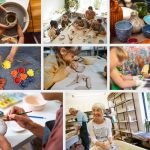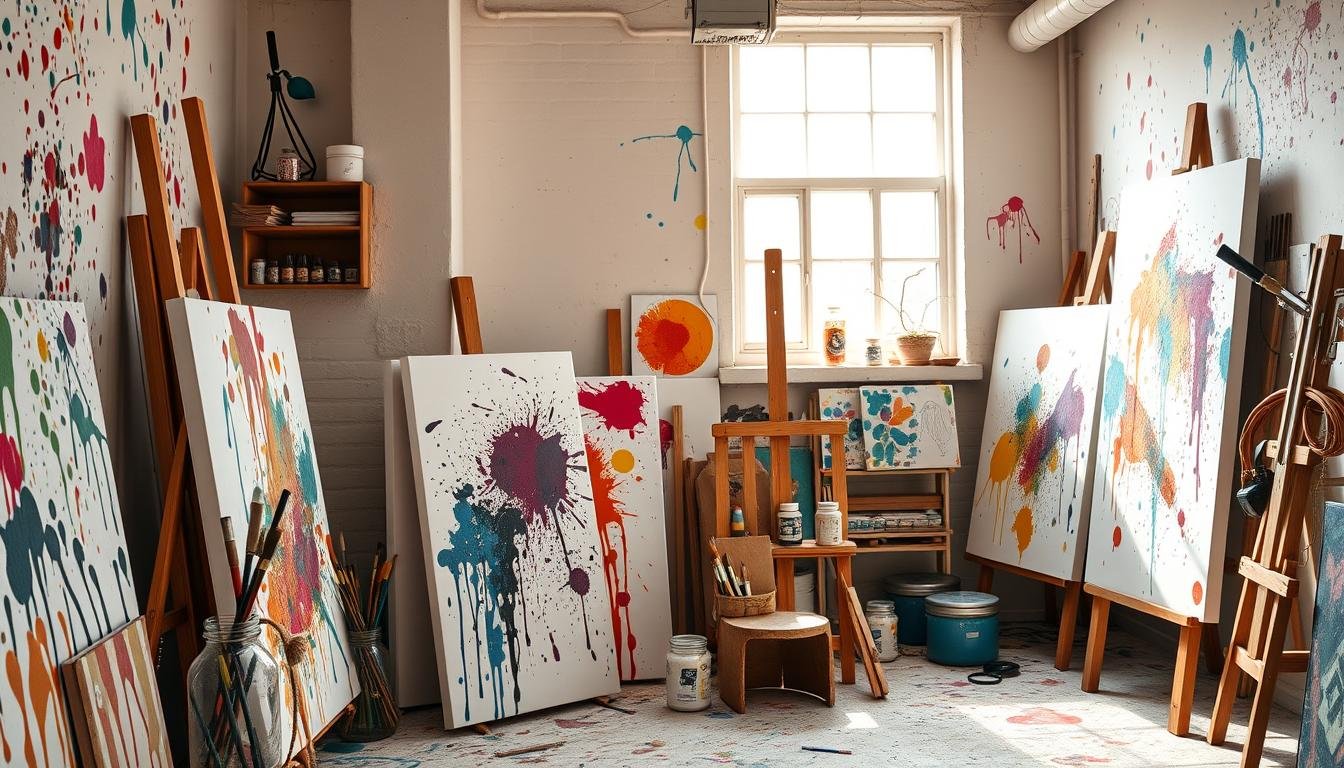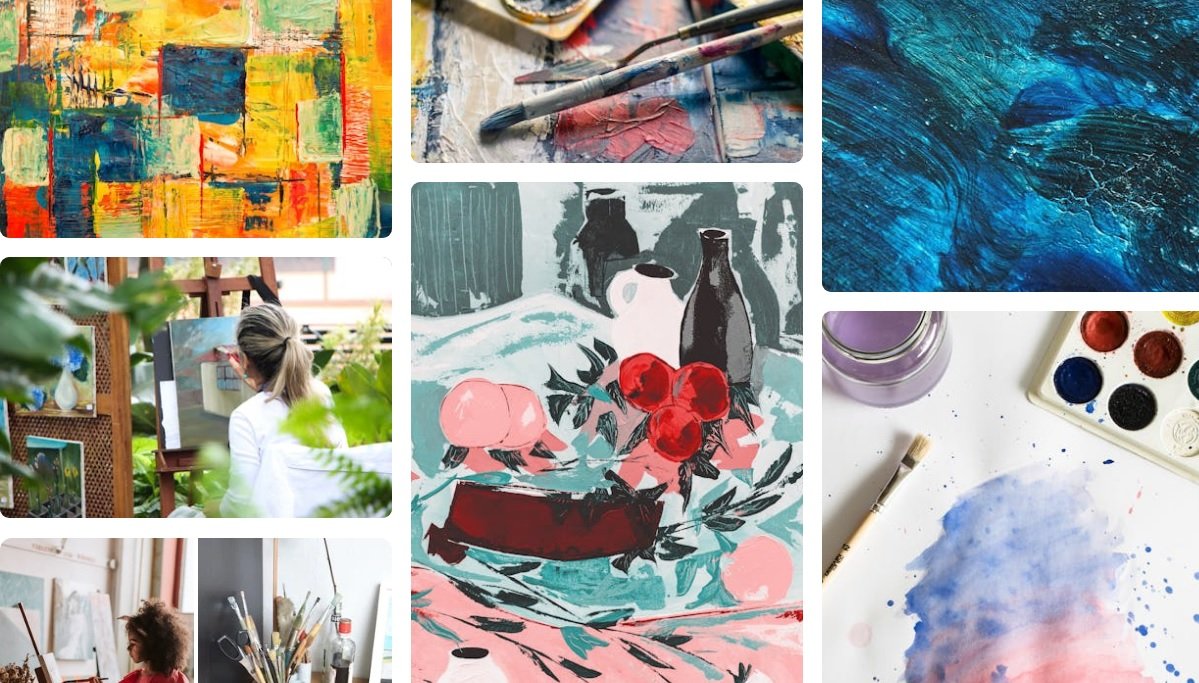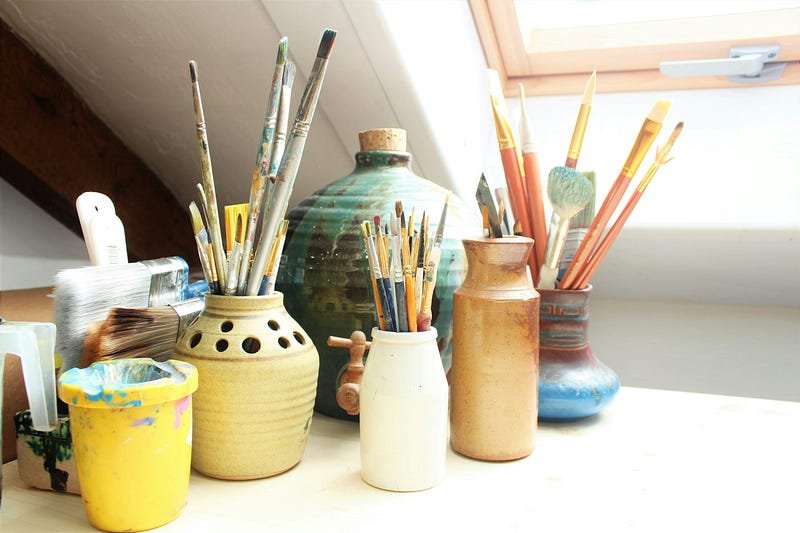World of Visual Art, Welcome to an amazing journey through the world of visual art. We’ll explore everything from painting’s timeless beauty to digital art’s new frontiers. This guide will show you the wide range of ways to express visually.
If you love art or want to learn more, this article is for you. We’ll cover the basics and the latest trends in visual art. You’ll see how art has evolved and how it continues to grow.
Key Takeaways
- Discover the rich history and evolution of visual art across mediums and genres.
- Explore the fundamental techniques and tools that form the foundation of visual expression.
- Uncover the creative potential within various art forms, from painting and sculpture to digital art and installation.
- Gain insights into the artistic process and how to cultivate your own unique creative voice.
- Understand the role of visual art in shaping our cultural and social landscape.
Unleashing Your Creative Potential
Creativity is key to artistic expression. Finding your unique voice is essential. We’ll look at ways to boost your creativity, use your experiences, and beat common artist challenges.
Discovering Your Artistic Voice
Your artistic voice shows your unique view of the world. It’s how you share your feelings, thoughts, and experiences. To find it, think deeply about yourself and what you love.
Try different ways to create until you find what feels right. This will help you express yourself in a way that’s truly yours.
Overcoming Creative Blocks
Even pros hit creative blocks sometimes. These can be tough, but there are ways to get past them. Try mindfulness, free-writing, or changing your space to spark new ideas.
Surround yourself with things that inspire you. This could be nature, art, music, or other creatives. Remember, being creative is a journey, not just a goal.
| Strategies for Overcoming Creative Blocks | Benefits |
|---|---|
| Mindfulness Practices | Reduces stress, enhances focus, and promotes a calm, creative mindset |
| Free-Writing Exercises | Unleashes spontaneous ideas and helps break through mental barriers |
| Changing Environments | Exposes you to new stimuli and can spark unexpected creative insights |
Mastering the Fundamentals of Visual Art
Creating amazing visual art starts with knowing the basics. We’ll explore the key elements that make art special. This will help you improve your art and make your ideas come to life.
Visual art is all about color theory, composition, and perspective. These basics help artists share their ideas, touch hearts, and grab attention.
Learning color theory is key for making colors work together. You’ll learn about hue, saturation, and value. This knowledge helps you create stunning art.
Composition is also vital. It’s about arranging things in a picture. By mastering balance, rhythm, and focal points, you’ll draw the viewer’s eye and tell a story.
Perspective adds depth to your art. Knowing linear, atmospheric, and two-point perspective makes your art feel real. It brings your art to life.
As you learn these basics, you’ll unlock your creativity. Start this journey and let these principles guide you in your artistic journey.
| Fundamental Element | Key Concepts | Importance |
|---|---|---|
| Color Theory |
| Creating harmonious and impactful palettes that evoke emotions and communicate ideas. |
| Composition |
| Guiding the viewer’s eye and creating a cohesive and visually compelling narrative. |
| Perspective |
| Capturing the illusion of three-dimensional space and adding depth and realism to artworks. |
“The fundamental principles of art are the building blocks of creative expression. Mastering them is the key to unlocking your full artistic potential.”
Exploring the Captivating World of Painting
Painting has been a favorite art form for centuries. It charms artists with its bold strokes and delicate washes. The world of painting is vast, offering endless ways to express creativity.
Oil Painting Techniques
Oil painting is known for its versatility. Artists can create rich, layered works with various techniques. From thick brushstrokes to smooth blends, oil paints invite endless exploration.
Mastering oil painting means understanding its unique properties. This includes knowing how it dries, mixes colors, and creates depth.
Watercolor Mastery
Watercolor paints are famous for their light, transparent quality. Artists must learn to control the medium’s flow. Techniques like wet-on-wet and dry brush help achieve different effects.
Watercolor painting demands a gentle touch and a grasp of color theory. This is how artists create vibrant, moving pieces.
| Technique | Oil Painting | Watercolor |
|---|---|---|
| Color Application | Opaque, Thick Layers | Transparent, Fluid Washes |
| Drying Time | Slow | Fast |
| Blending | Smooth, Seamless | Soft, Organic |
| Texture | Thick, Expressive | Delicate, Translucent |
“Painting is the silent poetry, and poetry is the speaking picture.” – Plutarch
Whether you love oil paints or watercolor, painting offers endless creative paths. By mastering techniques and exploring each medium, artists can fully express themselves. They can bring their visions to life on canvas.
Sculpting: Bringing Life to Form
Sculpting is a captivating art form that lets artists bring life to physical forms. They use clay, bronze, and stone to turn their visions into 3D art. We’ll dive into the world of sculpture, showing how these three-dimensional wonders are made.
The core of sculpting is clay sculpting. Artists shape clay to create detailed, expressive forms. They can make everything from realistic humans to playful animals. Clay’s flexibility lets artists bring their ideas to life.
Bronze casting is another favorite for sculptors. It turns clay or wax into lasting bronze sculptures. This ancient method requires skill and precision. Sculptors must carefully make molds and pour metal to get their desired outcome.
The art of sculpture deeply explores form, texture, and emotion. By mastering sculpting techniques, artists can share their visions with the world. Sculptures, from small ceramic pieces to large bronze statues, show the endless creativity of humans.
The Art of Drawing: From Sketches to Masterpieces
Drawing is the base of all visual art, opening doors to creative expression. We’ll explore drawing, from observing the world to expressing emotions. You’ll learn to improve your observational drawing and expressive drawing skills.
Observational Drawing
Observational drawing is about capturing details and proportions accurately. It can be a still life, landscape, or portrait. The key is to see and draw what you see well.
By sharpening your sketching skills, you can make drawings that are true to life. They will be full of authenticity.
Expressive Drawing Techniques
Expressive drawing is more about feelings and thoughts. It’s about showing your inner self through your drawings. Try using bold lines and different materials to express yourself.
“Drawing is the honesty of the art. There is no possibility of cheating. It is either good or bad.”
– Salvador Dalí
Drawing lets you explore and express yourself in many ways. Whether you like precision or freedom, drawing is a journey. Let your drawings show your unique vision.
Capturing Moments: The Beauty of Photography
Photography is a captivating art form that lets us freeze time and capture the world. Whether you’re experienced or just starting, learning about composition and lighting is crucial. It helps you take stunning, evocative photos.
Mastering Composition and Lighting
Composition is the base of any great photo. Knowing about visual balance, framing, and the rule of thirds helps you create images that grab attention. Lighting also plays a big role, affecting the mood, depth, and drama of your photos.
- Explore various photographic techniques to enhance your compositions, such as leading lines, symmetry, and the use of negative space.
- Experiment with different lighting conditions, from natural daylight to artificial sources, to achieve the desired effect.
- Learn how to manipulate lighting through the use of reflectors, diffusers, and other accessories to create depth, drama, and mood in your images.
- Develop an eye for composition, paying attention to the arrangement of elements within the frame and the overall balance of the image.
By mastering the mix of composition and lighting, you’ll take photography that’s both technically good and visually stunning. Embrace the art of photographic techniques and let your creative vision shine.
“The camera is an instrument that teaches people how to see without a camera.” – Dorothea Lange
Pushing Boundaries: The World of Installation Art
Installation art is a unique form of visual art that breaks the mold. It invites viewers into immersive experiences. Here, space, materials, and interaction come together to change how we see things.
At its core, installation art redefines what we think of as art. Artists use various materials and techniques to create installations that engage and make us think. It ranges from abstract ideas to urban landscapes, showing the endless creativity of humans.
Installation art emphasizes audience participation. Viewers are not just observers but active participants. This interaction between artist, artwork, and audience is dynamic and evolving.
“Installation art is about creating an environment that the viewer can engage with, rather than just observe.”
The influence of installation art, conceptual art, public art, and interactive art is clear. These forms are not just captivating but also spark deep thoughts on art and our world.
Embracing the Digital Age: Visual Art in the Modern Era
The world of visual art has changed a lot with the digital age. Now, artists can explore new ways to create through digital art, digital painting, and digital illustration. They use technology to make their art even more amazing.
Digital Painting and Illustration
Artists no longer stick to old ways like canvas and brushes. Thanks to technology in art, they have new tools and software. This lets them make art in fresh and exciting ways.
Digital painting mixes the feel of traditional painting with digital tools. Artists use stylus and graphics tablets to layer colors and textures. This gives them control and precision in their work.
Digital illustration has also grown as a way to tell stories through pictures. Artists can mix hand-drawn parts with digital changes. This makes their illustrations detailed and full of imagination.
“The digital canvas has become a limitless playground for artists, allowing them to transcend the boundaries of physical media and explore new realms of creative expression.”
The rise of digital art has changed the art world a lot. It lets artists share their unique views and reach people in new ways.
Conclusion: Embarking on Your Artistic Journey
As we wrap up our look into the world of visual art, we urge you to see the endless possibilities ahead. This journey, whether you’re an experienced artist or just starting, should have sparked your creativity. It should have made you eager to dive deeper into your artistic side.
The life of an artist is filled with growth and discovery. Face challenges, celebrate wins, and let your journey inspire you. As you start this amazing journey, may it fill you with joy, let you express yourself fully, and connect you more deeply with the world.
The creative process is a lifelong adventure with huge rewards. Let your imagination run wild and let your journey show the power of human expression. With every stroke, every sculpture, and every photo, you’ll discover more about your creativity and find your true artistic self.
FAQ
What is the purpose of this guide?
This guide takes you on a journey through the world of visual art. It covers many mediums and techniques. It’s for both seasoned artists and art lovers, aiming to inspire and inform.
What topics will be covered in this guide?
You’ll learn about unleashing your creativity and finding your artistic voice. It also covers the basics of visual art, like color theory and composition. You’ll explore painting, sculpting, drawing, photography, and digital art.
How will this guide help me in my artistic journey?
This guide empowers you in your artistic journey, no matter your skill level. You’ll learn techniques to unlock your creativity and overcome blocks. It helps you understand and appreciate the art-making process, leading to fulfillment and inspiration.
Who is this guide intended for?
It’s for anyone interested in visual art, including aspiring and professional artists. Art enthusiasts, those seeking inspiration, and students and educators will find value here.
How is the content of this guide organized?
The guide is divided into sections, each focusing on a different aspect of visual arts. You’ll explore creativity, fundamentals, painting, sculpting, drawing, photography, installation art, and digital art.
















